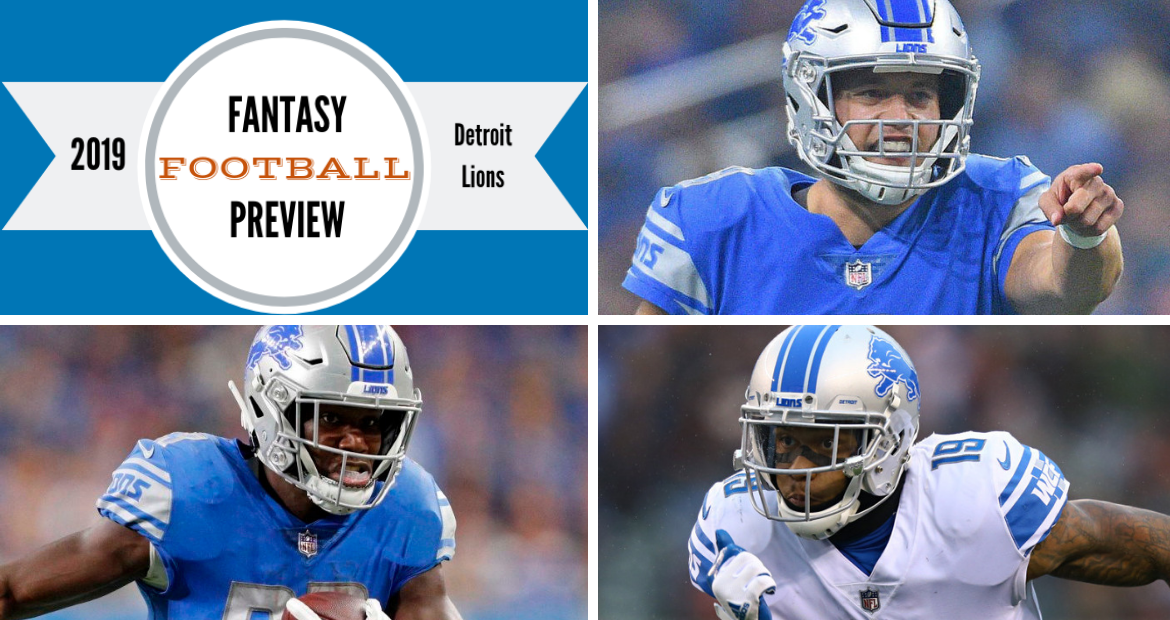
Fitz on Fantasy: 2019 Detroit Lions Buying Guide
With the preseason here, TFG fantasy expert Pat Fitzmaurice is breaking down the prospects for all 32 teams. Click here for a running list of teams, and check back often as teams are added on an almost daily basis. On to the Detroit Lions…
After the Lions sent Jim Bob Cooter back to Hazzard County and named Darrell Bevell as their new offensive coordinator, Bevell laid out the four core principles of his offense at a press conference:
1. Protect the ball.
2. “We’ll always be about running the football.”
3. Be “tough,” “hard-nosed” and “exert our will.” (If your eyes just rolled back in your head, you’re not alone; that’s the Holy Trinity of football coach clichés.)
4. Get big plays in the passing game.
In 1993, Bevell quarterbacked a ground-and-pound Wisconsin team to its first Rose Bowl victory since the ’60s, and he’s been a devotee of the running game ever since. Bevell’s offenses have finished top-three in rushing attempts in five of his 12 seasons as a play-caller. During Bevell’s seven-year tenure in Seattle, Marshawn Lynch had 280 or more carries in four straight seasons. In Minnesota, Bevell presided over 363-carry and 314-carry seasons by Adrian Peterson, and a 303-carry season by Chester Taylor.
Bottom line: Kerryon Johnson is going to eat.
It’s possible that a year from now we’ll be talking about Johnson as an early first-round pick. He was on pace for nearly 1,400 yards from scrimmage as a rookie before spraining his knee in his 10th game and missing the rest of the season. Johnson passed the eye test with flying colors and averaged 5.4 yards per carry, which was actually 0.5 yards better than his best per-carry average at Auburn.
Lions GM Bob Quinn has been dutifully fortifying Detroit’s offensive line. He took Taylor Decker in the first round of the 2016 draft and added Graham Glasnow two rounds later. Quinn took mauler Frank Ragnow in the first round of the 2018 draft. And in the first round of this year’s draft, Quinn added another player who can help open holes in the running game. (We’ll get to him in a minute.)
Enthusiasm for Johnson wasn’t totally unanimous this offseason, but after the Lions unloaded longtime passing-down RB Theo Riddick, a lot of the Kerryon fence-sitters got on the bandwagon. Johnson had already proven himself a capable pass catcher both at Auburn and as a rookie. He was on pace for 51 catches last year before the injury. With Riddick gone, Johnson is probably going to inherit a few extra targets in obvious passing situations. If his role in the passing game does indeed expand, and if the Lions are as run-heavy as anticipated, Johnson could have one of the biggest touch totals among all NFL running backs.
With the attractive workload/talent combo, Johnson warrants consideration in the second round of 12-team drafts. I’d consider taking him as early as 19th or 20th overall.
C.J. Anderson was an unlikely hero for the Rams last year on their drive to the NFC Championship. Signed off the street a little over a month after the Panthers released him, Anderson helped pick up the slack at the onset of Todd Gurley’s mysterious knee ailment. Anderson appeared to have eaten well during his brief hiatus from football, but the added girth didn’t appear to slow him down. Anderson topped 100 yards and scored a touchdown in each of the Rams’ last two regular-season games, then ran for 123 yards and two TDs in a win over Dallas in the divisional round of the playoffs. He wasn’t as effective in the NFC Championship Game or the Super Bowl, with 23 carries for 66 yards in those two games.
Anderson doesn’t really have stand-alone fantasy value since he’s a clear backup to Johnson and won’t catch many passes, but Johnson owners will probably want to secure Anderson’s services as a handcuff sometime during the second half of the season.
Matthew Stafford was one of the NFL’s most prolific chuckers for a long time. He led the league in pass attempts in 2011 and 2012, was top-five in 2013 and 2014, and was top-10 in 2015 and 2016. He finished 11th last year. It’s probably safe to say that if Stafford finishes among the leaders in pass attempts in 2019, things will have gone badly off-script for Bevell and the Lions.
If you’re inclined to believe Bevell when he says he’d dedicated to the running game, you’ll probably have trouble ginning up enthusiasm for Stafford’s fantasy outlook. He finished QB19 in fantasy scoring last year with the Lions ranking 14th in passing play percentage. If Detroit finishes in the bottom 10 in passing play percentage – a distinct possibility – Stafford probably won’t be a top-20 fantasy quarterback.
I have Stafford ranked QB26 and have no interest in him in single-QB leagues. In 2QB and superflex leagues, I’d be willing to roster him as my second quarterback if I skimped on the position in order to load up elsewhere.
Kenny Golladay is one of my favorite young receivers, and I have a ton of shares of him – probably too many. I took Kenny G. in damn near every best-ball draft I entered before Bevell’s hiring, then took him in a couple more best-balls after that because I couldn’t break the habit.
Golladay had 70 catches for 1,063 yards and five TDs last year, finishing WR20 in fantasy scoring. He ranked 14th in receiving yards, 16th in targets and 17th in air yards. It was a heady performance for a second-year player, but I’m worried that those numbers might slip a bit. Marvin Jones missed seven games last year. If Jones stays healthy and the Lions run more, Golladay could take a slight haircut in target volume.
After being such an avid Golladay buyer earlier, I now have him ranked WR20, which is below both his average draft position and expert consensus ranking. I’m still interested in him, but I’m not getting out over my skis anymore.
There are some sharp fantasy analysts who think the ADP gap between Golladay and Jones is far too wide. Golladay’s ADP is WR18; Jones’ is WR38. Jones is a talented receiver, no question. Just ask stud Vikings CB Xavier Rhodes, who was lit up for 9-109-2 by Jones two Thanksgivings ago. I think the ADP gap between the two Detroit receivers might be a smidge too wide, but I do believe Golladay has the superior fantasy profile as the still-ascending talent. Jones is 29 and required offseason surgery, which may partly explain the somewhat depressed ADP. Still, he’s a solid value at that price.
The third receiver is 33-year-old slot man Danny Amendola, who’s never had more than 689 yards or four TD catches in a season over his 10-year career. He’s only draftable in deep PPR leagues, and maybe not even then.
“I saw rock and roll future and its name is Bruce Springsteen.” – Jon Landau
I’ve always loved that quote even though I’m not a big Springsteen fan. So let me co-opt it for a moment:
I saw TE future and its name is T.J. Hockenson.
Rookie tight ends are generally sucker plays. They are the fermented herring placed inside a steel animal trap – only a hungry creature without the human capacity for logic would take the bait and disregard the ominous-looking contraption around it. O.J. Howard and David Njoku were outstanding TE prospects two years ago, but the smart move was to avoid them in redraft leagues in their rookie seasons.
Hockenson is the rare exception; I’m looking to get him in as many drafts as I can. The eighth overall pick in this year’s draft, Hockenson was an absolute marvel at Iowa last season. He’s the best blocking tight end to enter the league in years, and last fall he became an impact pass catcher who beat coverage in every which way. The superior blocking ability would seem superfluous for fantasy football except for this: It’s going to keep Hockenson on the field at all times. I think he’ll quickly become an impact pass catcher at the NFL level because he’s athletic, he’s savvy as hell about getting open, and he’s a beast with the ball in his hands.
If I can’t sell you on Hockenson in this limited space, let me turn you over to a far more articulate salesman, Rotoworld draft analyst Thor Nystrom (@thorku), who wrote this paean to Hock’s talents before the draft.
It would be absurd to call Hockenson a “league winner” (good lord do I hate that term), or assert that he can be a top-five fantasy TE in Year One. But I do think he has a good chance to produce within the TE1 range. People might scoff that I have a rookie ranked ahead of, say, Jordan Reed. But Reed is smaller, less athletic, gets hurt all the time and hasn’t given us useful fantasy numbers since 2016. I’d much rather have Hockenson a couple of rounds later.
| PLAYER | FITZ RANK | ECR | ADP | ADVICE |
| Matthew Stafford | QB26 | QB24 | QB24 | 2QB only |
| Kerryon Johnson | RB12 | RB12 | RB15 | Buy at cost |
| C.J. Anderson | RB70 | RB55 | RB63 | Fade |
| Kenny Golladay | WR20 | WR19 | WR18 | Fairly priced |
| Marvin Jones | Wr36 | Wr35 | WR38 | Solid value |
| T.J. Hockenson | Wr14 | WR21 | Wr18 | Grab him |
ADP = Average Draft Position ECR = Expert Consensus Ranking (based on half-PPR scoring)



